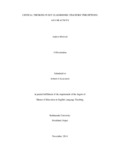
Please use this identifier to cite or link to this item:
https://hdl.handle.net/20.500.14301/244| Title: | CRITICAL THINKING IN ELT CLASSROOMS: TEACHERS’ PERCEPTIONS AND PRACTICES |
| Authors: | Bhetwal, Aadesh |
| Citation: | Bhetwal,A.(2014).Critical thinking in ELT classrooms: Teachers’ perceptions and practices. |
| Issue Date: | Nov-2014 |
| School: | SOED |
| Department: | DOLE |
| Level: | Masters |
| Program: | Master of Education in ELT (2 years) |
| Abstract: | This study was conducted to understand the perceptions and practices of English language teachers using the practices of critical thinking in English language teaching. In the changed scenario of education, ‘Critical Thinking’ has been one of the approaches to foster learning among students, and it has been in practice in classrooms for quite a long time now. This study was carried out using the procedures of qualitative research method. Six English teachers were the participants; among them three were from ‘lower secondary level’ and the rest were from ‘secondary level’. The data were collected through interviews and classroom observations. After collecting data, they were analyzed, interpreted and discussed using the principles of interpretive paradigm. The findings are shaped as per the ‘research questions’. The key findings of the present study are: The research participants are positive towards the use of critical thinking in teaching English language, and they have been adopting this approach as much as possible. However, they had certain limitations such as lack of trainings and guidance due to the lack of practical exposure. Most of the participants felt for adequate training sessions with experts make the classroom learning more interactive than before. As a whole, the participants found this approach in teaching very useful. The study also discovered different practices such as using language games, project works etc. that English language teachers used to enhance the critical ability of their students. This study also revealed that such practices were of significance while transferring the ‘teaching’ into ‘learning’. At last, this study contributes to the English language teaching fraternity to be open on the matter of critical thinking in classroom, and its pedagogical implications paves the way to the teacher of English to the usage of critical thinking. |
| URI: | https://hdl.handle.net/20.500.14301/244 |
| Appears in Collections: | Research Report |
Files in This Item:
| File | Description | Size | Format | |
|---|---|---|---|---|
| Draft 6.pdf | 1.2 MB | Adobe PDF |  View/Open |
Items in DSpace are protected by copyright, with all rights reserved, unless otherwise indicated.